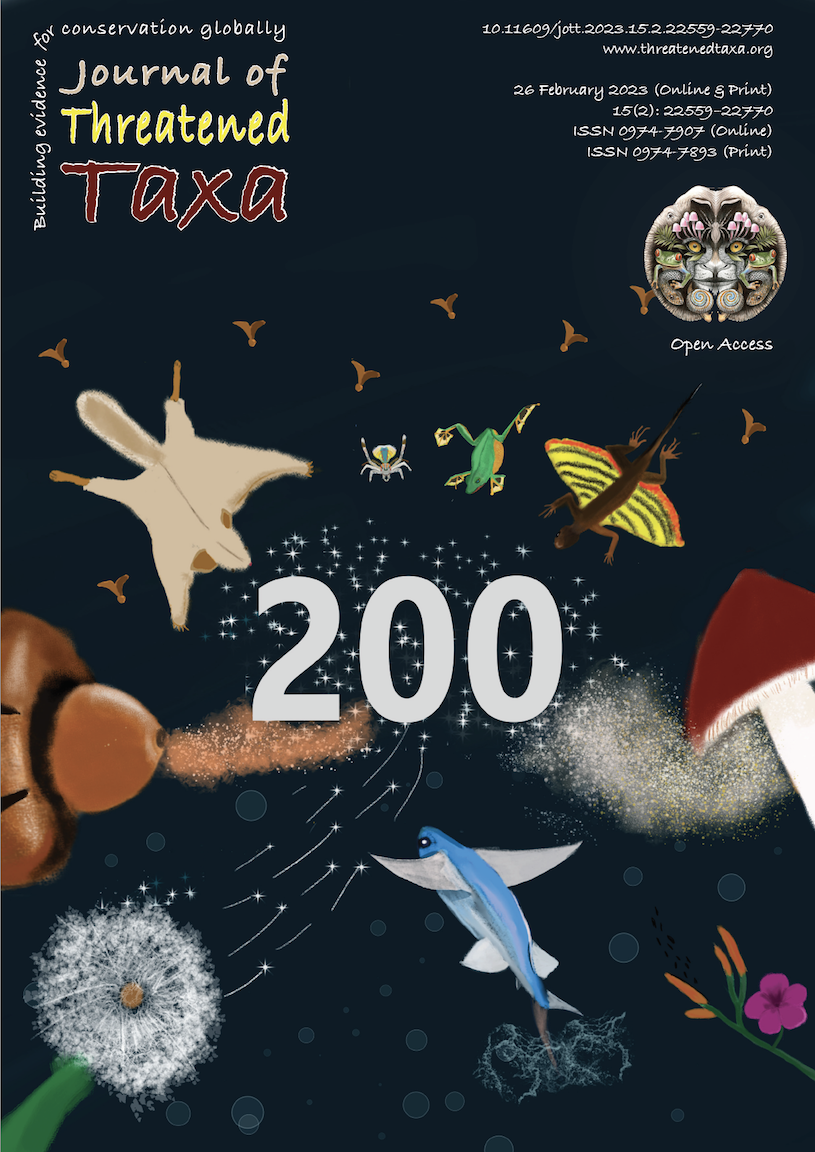Seasonal diversity and dietary guild structure of birds in two Vindhyan gorge forests of Rajasthan, India
DOI:
https://doi.org/10.11609/jott.7103.15.2.22597-22605Keywords:
Avifauna, Chainpuriya, gorge biodiversity, habitat, migratory birds, mountain range, northwestern India, TahlaAbstract
Habitat is the key factor of biodiversity conservation. In Vindhyan mountain range of India, there are many perennial and seasonal rivers which create deep gorges in their course of flow. Two Vindhyan gorges—Tahla and Chainpuriya—were studied to know their potential as bird habitat from July 2016 to June 2018 using line transect method during three season survey basis. The Tahla gorge had 74 bird species of 35 families (67 resident and 7 migratory). The Chainpuriya gorge had 60 bird species belonged to 31 families (53 resident and 7 migratory). Highest bird diversity (HT = 3.55, HCh = 3.29) and richness (dT = 9.63,dCh = 8.28) was found in summer and the least diversity (HT = 3.40, HCh = 3.19) and richness (dT = 7.95, dCh = 7.49) was found in monsoon. Birds of family Muscicapidae had highest relative diversity (T = 9.45, Ch = 13.33) in both the gorges. Insectivorous guild was most abundant followed by omnivorous, carnivorous, granivorous, frugivorous, and nectarivorous guilds. Wide range of habitats, variety of food, life resources, and undisturbed self-sustained ecosystem were important key factors for the rich diversity of birds in the gorges.
References
Ali, S. & S.D. Ripley (2007). Handbook of the Birds of India and Pakistan. Oxford University Press, New Delhi, India, Vol. 1–10.
Baral, H.S. & C. Inskipp (2005). Important Bird Areas in Nepal: Key Sites for Conservation. Bird Conservation Nepal and Birdlife International, 242 pp.
Bibby, C., M. Jones & S. Marsden (1998). Expedition field techniques Bird Surveys. Expedition Advisory Centre of Royal Geographical Society, 134 pp.
Gautam, R. & G. Kafle (2007). A preliminary survey of waterbirds in Phewalake, Kaski. Danphe 16(3/4): 6–8.
Grant, C. (2005). Carnarvon national park management plan. Environmental Protection Agency, The State of Queensland, 51 pp.
Gould, W. (2000). Remote sensing of vegetation, plant species richness and regional biodiversity hotspots. Ecological Application 10: 1861–1870.
Grimmett, R., C. Inskipp & T. Inskipp (2011). Birds of Indian Subcontinent. Oxford University Press, New Delhi, India, 528 pp.
Hornsby, P. (1997). Records of birds seen at Brindana gorge, in the north flinder ranges, South Australia. South Australian Ornithologist 32: 118–122.
Joshi, A.K. & C. Bhatnagar (2016). Diversity and habitat association of birds in a Vindhyan gorge of Kekariya, Rajasthan, India. Ambient Science 3(2): 55–60.
Kopij, G. (2013). Avian assemblages of river gorges in the Maloti/Drakensberg ‘hot-spot’ region, southern Africa. Zoology and Ecology 23: 171–182.
Malan, G. & R.E. Lerm (2013). Association between avian assemblages and mountain bushveld communities along a single mountain slope in the Usuthu Gorge, South Africa. Ostrich 84: 63–69.
Manchiryala, R. & R.M. Medicheti (2016). Breeding biology of critically endangered long-billedvulture (Gyps indicus) ata uniquesite in Telangana state, India. Ambient Science 3(1): 49–51.
Mekonen, S. (2017). Birds as biodiversity and environmental indicator. Advances in Life Science and Technology 60: 16–22.
Mowbray, T.B. & J.O. Henry (1968). Vegetation gradients in relation to environment and phenology in a southern Blue Ridgegorge. Ecological Monographs 38: 309–344.
Nikolov, S. & S.D. Spasov (2005). Frequency, density and numbers of some breeding birds in the south part of Kresna gorge (SW Bulgaria). Acrocephalus 26: 273–282.
Parnell, J.F. & T.L. Quay (1964). The summer birds of the Toxway River gorge of southwestern North Carolina. Wilson Bulletin 76(2): 138–146.
Patten, M.A., D.L. Reinking & D.H. Wolfe (2006). Avifauna of the Four Canyon preserve, Ellis County, Oklahoma. The Oklahoma Biological Survey, 2nd Series 7: 11–20.
Rahmani, A.R. (2015). Threatened Birds of India. BNHS and Oxford University Press, Bombay, 870 pp.
Sharma, S.K. & B.P. Singh (2006). Birds of the gorges of Vindhyas in Rajasthan state. Zoos Print Journal 21: 2167–2169.
Shurulinkov, P. & I. Nikolov (1989). Recent status of the breeding avifauna in the canyons of RousenskiLom River system, north-eastern Bulgaria. Ciconia, 77 pp.
Taylor, D.M. (1989). Notes on Hells Canyon birds. Great Basin Naturalist 49: 279–287.
Torre-Cuadros, M.D., L.A.L.S. Herrando-Perez & K.R. Young (2007). Diversity and structure patterns for tropical montane and premontane, forests of central Peru, with an assessment of the use of higher-taxon surrogacy. Biodiversity and Conservation 16: 2965–2988.
Singh, S. (2015). Geomorphology. Pravalika Publications, Allahabad.
Spence, J.R., T.L. Charles & D.G. John (2011). Birds of Glen Canyon National Recreation Area, Utah and Arizona. Western North American Naturalist 5: 20–70.
Published
Versions
- 26-02-2023 (2)
- 26-02-2023 (1)
Issue
Section
License
Copyright (c) 2023 Ashvini Kumar Joshi

This work is licensed under a Creative Commons Attribution 4.0 International License.
Authors own the copyright to the articles published in JoTT. This is indicated explicitly in each publication. The authors grant permission to the publisher Wildlife Information Liaison Development (WILD) Society to publish the article in the Journal of Threatened Taxa. The authors recognize WILD as the original publisher, and to sell hard copies of the Journal and article to any buyer. JoTT is registered under the Creative Commons Attribution 4.0 International License (CC BY), which allows authors to retain copyright ownership. Under this license the authors allow anyone to download, cite, use the data, modify, reprint, copy and distribute provided the authors and source of publication are credited through appropriate citations (e.g., Son et al. (2016). Bats (Mammalia: Chiroptera) of the southeastern Truong Son Mountains, Quang Ngai Province, Vietnam. Journal of Threatened Taxa 8(7): 8953–8969. https://doi.org/10.11609/jott.2785.8.7.8953-8969). Users of the data do not require specific permission from the authors or the publisher.





